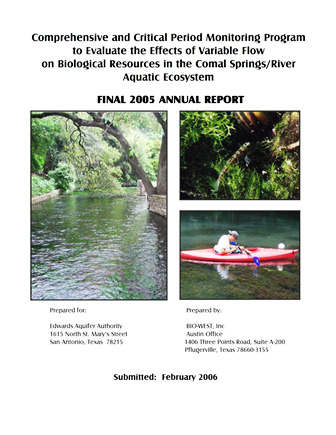Comprehensive and Critical Period Monitoring Program to Evaluate the Effects of Variable Flow on Biological Resources in the Comal Springs/River Aquatic Ecosystem Final 2005 Annual Report

| Summary |
|
The purpose of this report is to document the results of all aquatic ecosystem monitoring conducted in 2005 at Comal Springs located in New Braunfels, Texas. The monitoring and report preparation was performed by BIO-WEST, Inc. Pflugerville, Texas. [Excerpted from the Executive Summary] Overall, vegetation coverage increased at all sites following the high-flows of 2004. In most cases, flooding resulted in a temporary reduction in total aquatic vegetation coverage, but many plant types quickly responded with rapid re-growth and expanded to a total coverage that exceeded the preflooding condition…. Overall, the size-class distribution for fountain darters collected during the study period is typical of a healthy fish population with a peak near 30 millimeters (mm) total length (TL)…. In 2005, an effort was made to establish a rapid method for assessing changes in fountain darter population abundance between sample efforts, especially during critical periods (high- and low-flow events)…. Although not a fish, one exotic species which has had considerable impact on the vegetation community in the Comal Springs/River ecosystem in the past is the giant ramshorn snail (Marisa cornuarietis). Densities of these organisms have declined in recent years, and were at their lowest in 2005. However, since these snails can have severe impacts at high densities, their populations will continue to be monitored especially if a critical low-flow period occurs in 2006. In 2005, new methods were tested to help better identify changes in gill parasite drift densities during the year. These new methods will be implemented in 2006 to better understand drift rates of the parasite and infection rates of fountain darters…. All SCUBA/snorkel surveys revealed the presence of Comal Springs salamanders (Eurycea sp.) along the Landa Lake bottom and in each sampled Spring Run, except for the Spring Run at Spring Island in fall 2005…. Among species of concern, an average of 14.5 Stygobromus pecki (Peck’s cave amphipod, many small Stygobromus were unidentifiable to species), 3.2 Heterelmis comalensis (Comal Springs riffle beetle), and 1.3 Stygoparnus comalensis (Comal Springs dryopid beetle) were retrieved during each 24-hour period at all sites. S. pecki was found in all three locations…. A total of 1,009 Comal Springs riffle beetles were collected in all 2005 samples and the number of larvae (n=227) was far fewer than the number of adults (n=782). … The sampling methodology used in 2004-2005 has revealed a much larger population of Comal Springs riffle beetle along the western shoreline of Landa Lake than previous sampling had suggested. …These data suggest that the species has precise requirements (e.g., physical characteristics or food source) that govern its distribution…. Though the comprehensive portion of the study has been reduced to two annual samples (plus a limited summer effort), it is still adequate to maintain a continuous record of conditions. That is vital knowledge since antecedent conditions influence community-level response to reduced discharge conditions. Sampling only during a low-flow event will not provide the necessary context to adequately assess changes that occur during such conditions. |
Search for Documents
Advance Search
Explore EAA's Scientific Reports
- All Reports
- RZ Protection
- Aquifer Levels
- Remote Sensing
- Precipitation
- Overview Studies
- Modeling
- Hydrology and Hydrogeology
- History
- Groundwater Recharge, Recharge Zone
- Groundwater Movement
- Geomorphology and Caves
- Weather Modification
- Geology
- Water Use and Conservation
- Geochemistry
- Water Resources Planning and Management
- Floods and Drought
- Water Quality
- Climatology
- Surface Water / Groundwater Relationship
- Biology
- Springs, Groundwater Discharge
- Archaeology
